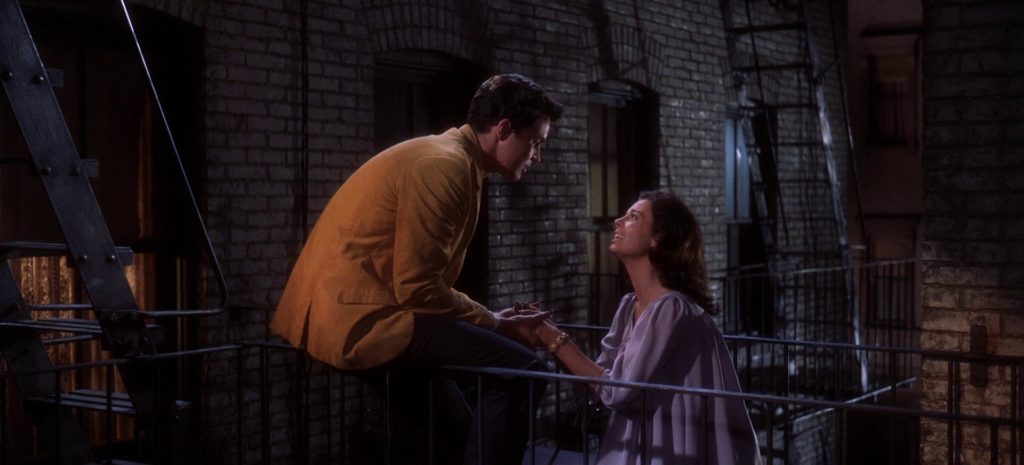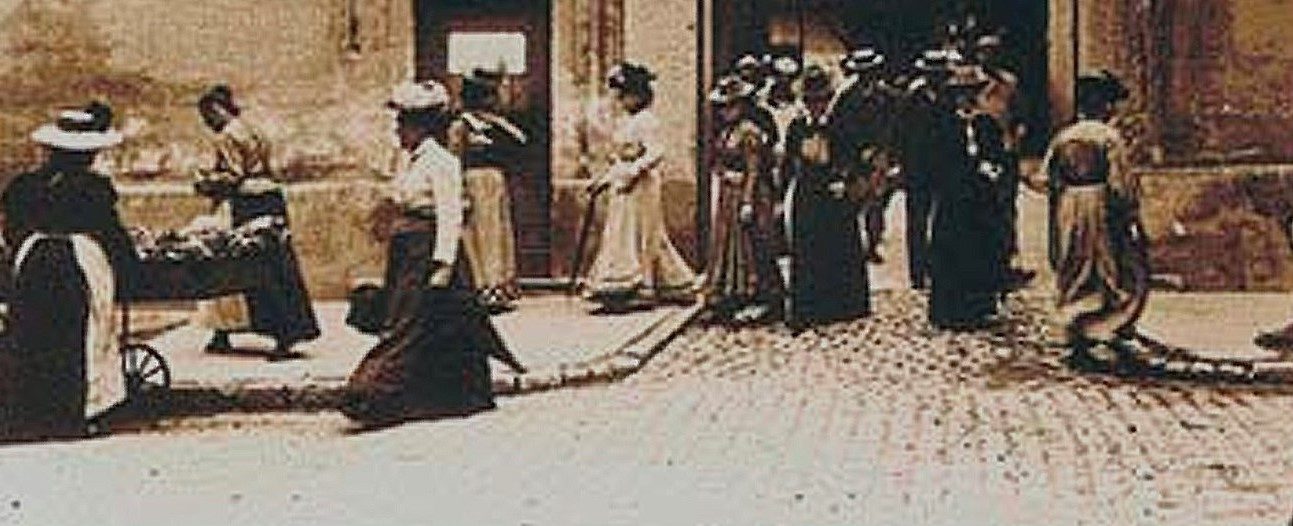United States, 1961
Directed by Robert Wise and Jerome Robbins
With Nathalie Wood (Maria), Richard Beymer (Tony), George Chakiris (Bernardo), Rita Moreno (Anita), Jose De Vega (Chino), Russ Tamblyn (Riff), Tucker Smith (Ice), Tony Mordente (Action), Simon Oakland (Schrank)

It started as a typical conflict between families and political allegiances in the 13th and 14th century Italy, in this case in Verona, which was turned into a literary work in the 15th century by some Italian writers. The narrative became then the source of plays, including in Spain, and it is was in the 1590s that the English Bard William Shakespeare wrote his great theatrical adaption. Later opera composers, like Charles Gounod, exploited the simple, powerful, star-crossed romance. And then, in the mid-20th century, in the New World, Broadway first and Hollywood later decided to fit the Romeo and Juliet tragedy into the musical genre.
But the plot is twisted to deal with fault lines of the American society. The aristocratic families are replaced by gangs of young men proud of doing nothing else than loitering, teasing, and scaring in the streets they pace all day, eager to protect their turf and playing the alpha males to assert themselves in a society they do not really trust and among adults who are not playing their roles: in this film, parents are astonishingly missing from the pictures (though Maria’s parents visiting the Big Apple can be heard during the reinvented balcony scene, but the camera does not show them and their presence do not keep the lovers from talking). The authorities, embodied by antagonistic and hard-headed police lieutenant Schrank, struggle to keep order, and make the task even more difficult by showing contempt, clearly fueled in part by racism, and resorting to verbal if not physical violence to deal with the boys, and their girls (the most disgraceful example of his viciousness takes place when Schrank looking for clues circles around Maria, interrogates her, jostles her, in her apartment after the bloody rumble that changed everything).
The story also deals with the mishaps of the melting pot. Who is an American and what it means divides the characters and breeds discontent, even between lovers. The difference in racial background intersects with the gang rivalry, and so the Jets, led by Riff, a blond-haired, white-skinned New York native with a round face, seconded by Ice and Action, try to keep their turf safe from the ambitions of the Sharks, led by Bernardo, a dark-haired, brown-skinned Porto Rico native with an angular face, aided by Chino – the battle for the streets pits Whites against Hispanics, those whose families have been in the place for a long time and those who have just arrived (although they come from a territory ruled by the United States), those holding their grounds and those hoping to make it.
But the fight features also a critical approach to the American dream by the migrants who landed in the country: the song “America” is a stunning, vibrant exchange between the Sharks gang members and their girls, two rivaling choirs led respectively by Bernardo and his girlfriend Anita, the latter extolling the virtues America stands for and the relief immigration is compared to the poverty of the native land, while, with a biting irony, the former emphasizes the troubles the immigrants face in reality, how hope is betrayed and opportunity denied. The melting pot is cast as a narrative that is as seducing as it is misleading, replete with promises doomed to be elusive, and yet appealing enough to drive people to try their luck – as it is the case of Bernardo’s sister, Maria, who is supposed to earn money for her family and to marry Chino.
Like life in America, love is full of expectations, defined by them, sustained by them. “Something’s Coming”, sings Tony, the former leader and co-founder of the Jets. His blue eyes and blue shirt match but contrast with the reddish walls of the back alley where he is moving away the crates of bottles to carry them in the basement of the bar where he works: an energetic but dreamy boy waiting for the extraordinary person or event that would change his life, actually carry him even further away from the dullness and delinquency thriving around him. The number ends with the camera moving up, leaving at the bottom the hopeful boy and focusing on the laundry spread over his head: the image delicately blurs, morphs, and leads to the clothes and fabrics that make up the work environment of Maria, as she eagerly waits for Anita to finish the dress she is supposed to wear at a ball. What a nice transition, with clothes and fabrics embodying the expectation of fun and pleasure in a life ruled by work and the weak hope something great could happen.
Time and people get frozen as the two young dreamers notice each other. Love at first sight is expressively and wonderfully illustrated and the bond seems hard to break even as the antagonistic gang members and their girls rush to the spot to see it Maria and Tony do not stay together. Indeed, they meet again, and again. Their passion holds the promise to reach an ideal, better “Somewhere” and more daringly becomes a spur to challenge the gang mindset and influence, especially for Maria. Fate nevertheless has decided otherwise: the two gangs organize a brawl to settle their scores, and the rumble is a shocking disaster: not only Tony is unable to keep the gang leaders from fighting each other, including with blades, but he is drawn in the fight. Bernardo kills Riff and is killed by Tony. Blood alters the picture for the gangs.
Not for the lovers: even after word of the massacre spread, Tony and Maria meet again and keep loving each other. Colors, lights, positions of the bodies within the frame tell the moving story of two worlds that should be apart but circle around each other, and then embrace each other, contrast leading to harmony. Despite the absolute horror Maria and Tony cannot give up on each other. But violence and distrust decide otherwise and an elaborate series of confrontations between antagonists lead to the final tragedy, the killing of Tony by Chino. What follows, however, is a departure from the legend and the Shakespearean play (which the film abides by as far as time and tempo are concerned: the plot unfolds at a rather fast pace over two days and two nights, each of these nights being defined by a key gathering). Maria does not kill herself, or gets killed. She instead stands up as the moral conscience and forcing moral changes. The final shot is a ground slowly emptied by the actors in the dark of the night, as they follow the little group of Sharks and Jets bearing the corpse of Tony, Maria behaving as the dignified widow, Schrank quietly doing his work, without mistake nor provocation, as he takes Chino away. Reconciliation is always possible, as suggested by the play, but it does not call for sacrifice, just for passion, in this zesty Hollywood vision.
Colors, lights, and camera position: “West Side Story” is a great work of carefully crafted cinematography, with a superb palette of colors and great choreography, even when the cast does not really dance. Spaces, be it a back alley or a bedroom, are fully used and explored, highlighting the dynamics between the individuals or the sheer energy moving them. Many shots are just compelling and striking. The way a scene is cut to another holds often stunning surprises, a sense of transition that can be truly intelligent and bold. It does not always relies just on images and tricks: the tension that builds up as the gangs get ready for the rumble and the lovers hope the best can still come out of the coming night is carried as much by hectic editing than the continuous melody of the “Tonight” song.
Indeed, the quality, the beauty, the melody of the score rank among the best that the genre has produced, and the lyrics of Steven Sondheim and the music of Leonard Bernstein have proved to be an instant and lasting success. They are nicely completed by the confident work of directors Robert Wise and Jerome Robbins. The choreography imagined by the latter is often appealing and seducing, ensemble works that capture the energy and the strength of the young characters (though it sometimes feel awkward to watch delinquents chasing each other in the streets while pirouetting and springing legs wide open).

